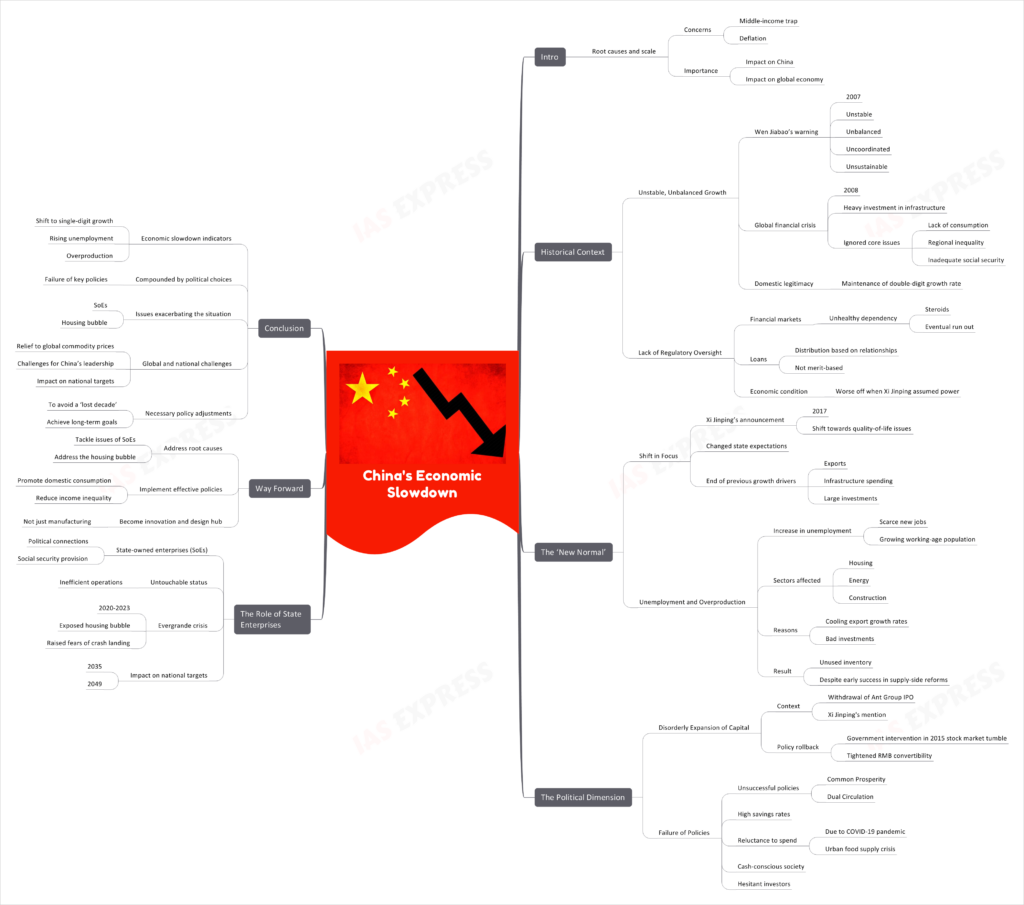China’s Economic Slowdown- Why is it Happening?
China’s economic slowdown has sparked a variety of reactions, with concerns about a middle-income trap and deflation potentially bringing negative impacts for both China and the global economy. Understanding the root causes and scale of China’s current economic challenges is crucial.

This topic of “China’s Economic Slowdown- Why is it Happening?” is important from the perspective of the UPSC IAS Examination, which falls under General Studies Portion.
The Historical Context
Unstable, Unbalanced Growth
In 2007, Premier Wen Jiabao warned that China’s economy was unstable, unbalanced, uncoordinated, and unsustainable. Although it was expected that corrective actions would be taken, the global financial crisis in 2008 led China to invest heavily in infrastructure, thereby ignoring core issues like lack of consumption, regional inequality, and inadequate social security. This approach was taken to maintain the double-digit growth rate essential for domestic legitimacy of the leadership.
Lack of Regulatory Oversight
The financial markets in China suffered due to inadequate regulatory oversight, with loans distributed based on relationships rather than merit. This led to an unhealthy dependency on “steroids” that eventually ran out, leaving the economy worse off by the time Xi Jinping assumed power.
The ‘New Normal’
Shift in Focus
In 2017, President Xi Jinping announced a shift in focus towards quality-of-life issues, acknowledging changed expectations from the state and the end of growth driven by exports, infrastructure spending, and large investments. This marked the beginning of a ‘new normal,’ where China had to adapt to a life of single-digit growth after enjoying more than 10% growth for over two decades.
Unemployment and Overproduction
This transition resulted in increased unemployment as new jobs became scarce, despite a growing working-age population. Additionally, the cooling of export growth rates and bad investments led to overproduction in sectors like housing, energy, and construction, resulting in unused inventory despite early success in supply-side reforms.
The Political Dimension
Disorderly Expansion of Capital
The withdrawal of the Ant Group IPO and Xi Jinping’s mention of “Disorderly expansion of capital” signaled significant implications. Despite promising to allow markets a greater role in resource allocation in 2013, the government intervened during the stock market tumble in 2015 and tightened the convertibility of the RMB.
Failure of Policies
Policies like “Common Prosperity” and “Dual Circulation,” aimed at better sharing progress and increasing domestic consumption, have not achieved the desired success. High savings rates, reluctance to spend due to the COVID-19 pandemic, and an urban food supply crisis have led to a more cash-conscious society and hesitant investors.
The Role of State Enterprises
State-owned enterprises (SoEs) have been a persistent issue due to their political connections and social security provision, making them untouchable despite their inefficient operations. The Evergrande crisis (2020-2023) exposed the housing bubble and highlighted the broader issues affecting the Chinese economy, raising fears of a crash landing and affecting China’s national targets for 2035 and 2049.
Way Forward
To avoid a ‘lost decade,’ China must address the root causes of its economic challenges. This includes tackling the issues of SoEs, addressing the housing bubble, and implementing policies that genuinely promote domestic consumption and reduce income inequality. Additionally, China must work towards climbing up the value chain and becoming a hub for innovation and design rather than just manufacturing.
Conclusion
China’s economic slowdown, marked by a shift to single-digit growth, rising unemployment, and overproduction, has been compounded by political choices and the failure of key policies. The issues with SoEs and the housing bubble further exacerbate the situation. While the slowdown may bring some relief to global commodity prices, it poses significant challenges for China’s leadership and its national targets. Addressing these challenges head-on and making necessary policy adjustments is crucial for China to avoid a ‘lost decade’ and achieve its long-term goals.
Practice Question for Mains
Why is China facing an economic slowdown? Discuss. (250 words)

